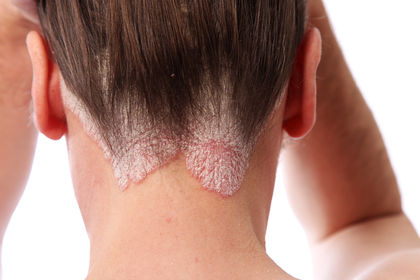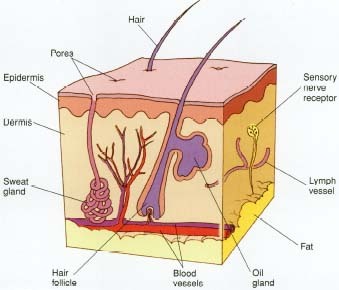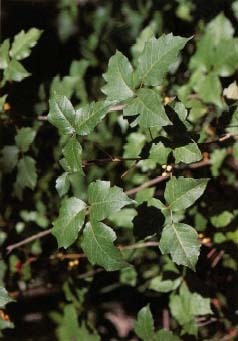Skin Conditions

Skin conditions include various rashes, diseases, infections, injuries, growths, and cancers that affect the skin.
KEYWORDS
for searching the Internet and other reference sources
Birthmarks
Dermatitis
Eczema
Herpes
Melanoma
Moles
Rash
Leaves of Three, Let Them Be
Alison loved to take long walks in the woods in the summer, but one day she developed a streaky rash two days after she had gone on a hike. At first, her skin was red and swollen in spots. Soon, however, little blisters formed and began to itch intensely. Alison had developed a rash from poison ivy. Her mother warned her not to scratch, because her fingernails might carry germs that could cause an infection. It was hard to resist, but cool showers and a soothing lotion helped. Within a few days, the blisters began to scab over. It took about 10 days for the rash to heal completely. Afterward, Alison was careful to wear long-sleeved shirts and long pants when walking in the woods and to stay away from poison ivy, identifiable by its clusters of three leaves.
What Does the Skin Do?
The skin is the largest and most visible organ of the body. It also is one of the most complex, because it has so much to do. The main job of the skin is to protect a person's inside parts from the outside world. It acts as

What Can Go Wrong?
It is not surprising that many things can go wrong with an organ so big and complicated. Allergens and irritants can make the skin break out in a rash. Dermatitis (der-ma-TY-tis) is a general term for red, inflamed skin from a variety of causes.
There also can be glitches in the way the skin works. For example, it can make too much oil, leading to acne (AK-nee). If the skin makes too many new cells, the result can be psoriasis (so-RY-a-sis). If the skin makes too little or too much coloring matter, called pigment, the result can be patches of abnormally light skin (hypopigmentation) or dark skin (hyperpigmentation).
The skin also can be affected by injuries, such as sunburn, and by viral infections, such as cold sores. Other kinds of skin infections are caused by bacteria and fungi. In addition, the skin can be affected by both noncancerous growths, such as birthmarks, and skin cancers.
Skin Deep
- The average adult body has two square yards of skin, which make up about 15 percent of the body's total weight.
- A one-inch square of skin contains millions of cells as well as many special nerve endings for sensing heat, cold, and pain.
- The average thickness of skin is onetenth of an inch, but it ranges from very thin on the eyelids to thick on the soles of the feet.
What Are Some Common Skin Problems?
These are some of the most common skin problems seen by dermatologists (der-ma-TOL-o-jists), doctors who specialize in treating skin problems:
- Acne: pimples, blackheads, whiteheads, and deeper lumps. Almost all teenagers have at least a little acne, and some adults have the problem as well. Acne develops when the skin makes too much oil and sheds dead cells too fast. Bacteria also plays a role.
- Athlete's foot: a fungal infection that may cause the skin on the foot to look red and peel, crack, flake, or even blister. Sweaty feet and tight shoes provide the perfect setting for a fungus to grow. Athlete's foot is most common among teenagers and adult men.
- Atopic (ay-TOP-ik) dermatitis, also called eczema (EK-zem-ah) : a red, itchy rash that often runs in families and accompanies allergies. In babies, it typically leads to itching, oozing patches with scabs, mainly on the face. In older children, the patches tend to be dry, and the affected skin may flake and thicken. In teenagers, the patches usually occur inside the elbow bends, backs of knees, ankles, wrists, face, neck, and upper chest.
- Birthmarks: a skin mark that develops before or shortly after birth. Several kinds of common birthmarks are caused by overgrowth of blood vessels. Such marks are usually painless.
- Cold sores: an infection caused by the herpes (HER-peez) simplex virus that leads to sores, usually around the mouth and nose. Some sores are barely noticeable, but others hurt. Cold sores are common among children and are easily spread from person to person by kissing or sharing dishes or towels.
- Contact dermatitis: a red, itchy rash that occurs when the skin comes into contact with an allergen or something else to which the skin is sensitive. Examples include poison ivy and sensitivities to nickel, rubber, and skin care products.
- Dandruff. flaking of the skin on the scalp. Some flaking is part of the normal process by which the outer layer of skin cells is regularly shed. If the flaking becomes obvious on a person's hair and clothes, it is called dandruff. If the scalp is red or if there are large flakes along with flaking elsewhere, the problem may be something else.
- Hives: pale red, swollen bumps that occur in groups on the skin. Hives are usually itchy, but they may also burn or sting. They are caused when the body releases a chemical called histamine (HIS-ta-meen) as part of a reaction to such things as foods, medications, insect bites, infections, cold, or scratching of the skin.
- Irritant dermatitis: a red, itchy rash that occurs when the skin comes into contact with a harsh chemical. Examples of irritants include strong soaps or detergents and industrial chemicals.
-
Moles:
growths that can appear anywhere on the skin, alone or in groups. They
are usually brown and can have various shapes and sizes. Everyone has at
least a few moles, and some people have forty or more. Most moles are
not cancerous, but some may turn into a serious form of skin cancer
called malignant melanoma (mel-a-NO-ma).
 Poison ivy plant (Rbus radicanus). Its green leaves turn red in the fall.© C Allan Morgan, Peter Arnold, Inc.
Poison ivy plant (Rbus radicanus). Its green leaves turn red in the fall.© C Allan Morgan, Peter Arnold, Inc. -
Poison ivy:
a common type of contact dermatitis that occurs when a sensitive person
comes into contact with a substance found in the sap of poison ivy
plants. Poison oak and poison sumac (SOO-mak) plants can have the same
effect. The result is a streaky rash with redness and swelling, followed
by blisters and itching. About 85 percent of all people will have this
kind of allergic reaction to poison ivy.
BoTox and Wrinkle Relief
One of the drugs in the fight against wrinkles is called BoTox. BoTox, short for Botulism Toxin type A, is a byproduct produced by the bacterium Clostridium botulinum. In food, the bacterium causes a potentially fatal type of food poisoning known as botulism. To remove wrinkles, a small amount of BoTox is injected into the muscles underthe wrinkled skin. The BoTox temporarily paralyzes the muscles and restricts their movement. The result, after 3 to 5 days, is that the wrinkles temporarily disappear. This is not a permanent treatment—it must be repeated every 3 months.
- Psoriasis: a long-lasting skin disease caused when too many new cells are made, resulting in patches of red, thickened skin covered with silvery flakes. Four to 5 million Americans have psoriasis. It may result from a problem with the immune system, which normally fights germs and other foreign substances in the body.
- Ringworm: a skin infection caused by a fungus (not a worm). Ringworm is marked by red, itchy, ring-shaped patches that may flake or blister. It commonly affects the feet, scalp, trunk, nails, and groin.
- Rosacea (ro-ZAY-she-a): a skin disease that causes redness and swelling on the face that may gradually spread to the cheeks and chin. Small blood vessels and tiny pimples may appear on or around the red area. Fair-skinned adults, especially women, are most likely to get rosacea.
- Seborrheic (seb-o-REE-ik) dermatitis: a common condition that causes red skin and greasy-looking flakes, mainly on the scalp, on the sides of the nose, between the eyebrows, on the eyelids, behind the ears, or on the chest. In babies, this condition is called cradle cap. In adults, it often occurs in people with oily skin and hair, and it may occur in those with acne or psoriasis.
- Shingles: a skin eruption caused by the same virus that causes chickenpox. It starts with pain or tingling on one side of the body or face, followed by a red rash with small blisters. After a person has chickenpox, the virus may live on in the nerve cells and come out years later as shingles. An episode of shingles may last weeks.
- Skin cancer: the most common of all types of cancer, including various kinds of growths on the skin. About 700,000 Americans get skin cancer each year. The main cause is the sun's harmful rays. Sunburn: the immediate result of getting too much sun. The skin is injured, just as if it had been burned by heat, and turns red and painful. If the sunburn is severe, blisters may form. The long-term effects of sun damage include wrinkles, certain skin bumps and spots, and skin cancer.
- Vitiligo (vit-i-LY-go): a condition that causes white patches of skin due to a loss of pigment in the cells and tissues. It affects 1 or 2 out of every 100 people. Although vitiligo strikes people of all races, it is particularly noticeable in those with dark skin.
- Warts: small, hard bumps on the skin or inner linings of the body that are caused by a virus. Most are skin-colored, raised, and rough, but some are dark, flat, or smooth. Warts are common on the fingers, hands, arms, and feet. Some warts occur on the genitals and can be spread during sex.
- Wrinkles: a common sign of skin aging. The main cause of wrinkles is getting too much sun over a lifetime. Cigarette smoking also plays a major role.
Rash Thoughts
These are the medical terms for some common skin spots and bumps:
- Comedo (KOM-ee-do): a blackhead, whitehead, or pimple. Example: acne.
- Macule (MAK-yool): a small, flat, colored spot. Example: freckles.
- Papule (PAP-yool): a small, hard bump. Example: warts.
- Plaque (PLAK): a large, raised patch of skin. Example: psoriasis.
- Pustule (PUS-tyool): a pimple filled with pus. Example: acne.
- Wheal (WEEL): a short-lasting, swollen bump. Example: hives.
How Are Skin Conditions Diagnosed?
Nearly everyone has a skin problem at some point in life. Such problems can affect anyone, from newborns to older adults. A doctor can identify many skin problems just by looking closely at the skin. The doctor may also ask about the person's current symptoms, past illnesses, and family history.
In some cases, the doctor may need to do a biopsy (BY-op-see). This involves removing a small bit of skin so that it can be looked at under a microscope. If an infection caused by a fungus is suspected, the doctor may scrape off some skin flakes, which can be checked at a lab for signs of fungus. Another way to check for an infection caused by bacteria or a fungus is with a culture. This involves taking a sample from the site of possible infection and placing it in a nourishing substance called a medium to see what kind of bacteria or fungi grow.
If contact or allergic dermatitis is suspected, the doctor may do patch testing to find out what allergens are to blame. This involves putting tiny amounts of different substances on the skin under a patch. The skin is checked 2 days later to see which substances, if any, caused a reaction.
How Are Skin Conditions Treated?
- Medicines: Many medicines used to treat mild skin conditions are sold without a prescription in creams, lotions, gels, pads, and shampoos. Stronger medicines that are put on the skin, taken by mouth, or given in a shot are available only from a doctor or with a doctor's prescription.
- Surgery: Doctors use several kinds of surgery to remove or destroy abnormal skin tissue. Excision involves removing a skin growth by cutting. Cryosurgery involves destroying a skin growth by freezing it with an extremely cold liquid such as liquid nitrogen. Electrosurgery involves destroying a skin growth by burning it with electricity. Laser surgery involves destroying skin tissue with a laser—a tool that produces a very narrow and intense beam of light. Surgery is used for such things as warts, skin cancer, moles, and birthmarks.
- Light therapy: Doctors treat certain skin problems with lamps that give off ultraviolet rays. In some cases, the person also takes a drug that makes the skin more sensitive to ultraviolet light. This therapy is used for such things as psoriasis and vitiligo.
The Skinny on Skin Care
These tips can help keep a person's skin feeling healthy and looking its best:
- Protect the skin from the sun's harmful rays. Avoid the midday sun, cover up with clothing, and use a good sunscreen with an SPF of 15 or higher.
- Wash the face gently with lukewarm water, a mild soap, and a washcloth or sponge to remove dead cells.
- Reduce dry skin by keeping baths short and using warm water. Use soap only as needed on the face, underarms, genitals, hands, and feet.
- Dry off the skin after bathing by brushing it lightly with the hands or patting it with a towel.
See also
Acne
Albinism
Allergies
Athlete's Foot
Herpes
Hives
Psoriasis
Ringworm
Skin Cancer
Vitiligo
Warts
Resources
Book Chapter
"Chapter 30. Your Skin." In: David E. Larson, editor. Mayo Clinic Family Health Book, 2nd edition. New York: William Morrow, 1996.
Organizations
American Academy of Dermatology, P.O. Box 681069, Schaumburg, IL
60168-1069, (888) 462-DERM. A group of doctors who treat skin diseases.
http://www.aad.org
American Society for Dermatologic Surgery, 930 N. Meacham Road,
Schaumburg, IL 60173, (800) 441-2737. A group of doctors who do surgery
on the skin.
http://www.asds-net.org
National Institute of Arthritis and Musculoskeletal and Skin Diseases, 1
AMS Circle, Bethesda, MD 20892-3675, (301) 495-4484. A federal agency
that studies skin diseases.
http://www.nih.gov/niams
Comment about this article, ask questions, or add new information about this topic: